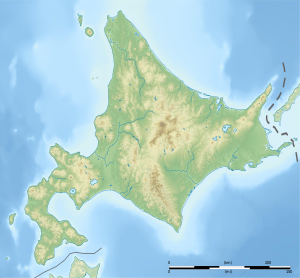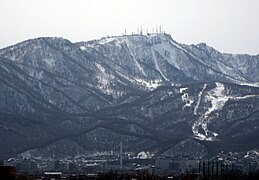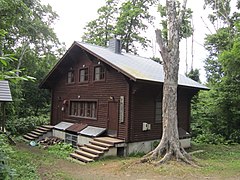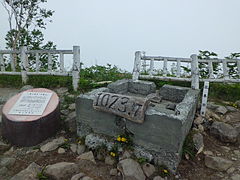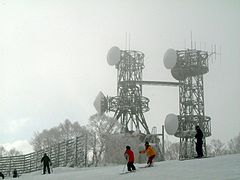Teine (mountain)
| Lines | ||
|---|---|---|
|
Panorama view of the Teine |
||
| height | 1023.1 m TP | |
| location | Sapporo , Hokkaidō | |
| Mountains | Nasu volcanic belt | |
| Coordinates | 43 ° 4 '36 " N , 141 ° 11' 33" E | |
|
|
||
| Type | Extinct volcano | |
| rock | Andesite , slate , tuff | |
| Age of the rock | Pliocene | |
| Development | Cable cars, road | |
| particularities | Sapporo Teine winter sports area | |
The Teine ( Japanese 手 稲 山 , Teine-yama ) is a mountain on the Japanese island of Hokkaidō . It is 1023.1 m high and is located in the urban area of Sapporo , about 15 km west of the city center. Mining was once used on the north side , while today the Sapporo Teine winter sports area is particularly important.
Geology and topography
The Teine is a volcano that went extinct millions of years ago and belongs to the Nasu volcanic belt. It lies between the Ishikari plain in the north and the upper Toyohira valley in the south; he shields Sapporo's city center from the west. The border between the Teine-ku and Nishi-ku districts runs across the summit . It is considered certain that the Teine has not been active since the Pliocene , i.e. for at least 2.6 million years. The predominant rocks are andesite , slate and tuff . To the west of the summit there are ridges, in the north and south there are steep cliffs. Presumably there was a volcanic crater below the northern rock face . The eastern flank is gently sloping, which suggests a lava flow .
The name of the mountain is derived from the word teyne-i in the Ainu language , which can be translated as “moor” or “wet spot”. He refers to the former wetlands at the north foot of the mountain.
Mining
Since the Meiji period there have been repeated finds of gold dust at the Hoshioki brook, which rises on the north side of the Teine and separates Sapporo from the neighboring town of Otaru . Around 1890, a farmer came across a small gold vein. Subsequent attempts at commercial mining were initially unsuccessful due to insufficient yields. Hiroshi Shozaburo acquired the mining rights in 1928 and opened the Teine mine a year later on Takinozawa, a stream that flows into the Hoshioka . Mitsubishi Mining (now Mitsubishi Materials ) took over in 1935. In addition to gold and silver , copper and zinc in particular were mined. The transport was carried out by cable car to Teine train station . The mine was particularly important during the Pacific War .
After the end of the war, the output decreased significantly due to a lack of demand. Mitsubishi was forced to reduce the workforce to a third by 1947. In 1954, Arakawa Mining took over the ever smaller operation and limited itself to the mining of high-grade ore. However, this was soon exhausted and the mine was sold to Chitose Mining in 1961, which was now mining the low-grade ore. Finally, in 1971, the mine had to be closed for good.
Various minerals have been discovered in the mine, including the named after the Teine mine Teineit in 1939 and Watanabeit in 1,992th
sport and freetime
At the end of the Meiji period, a mountain hiking trail was created up to the summit. In 1926, the winter sports club at the University of Hokkaidō built the Paradise Hut ( パ ラ ダ イ ス ・ ヒ ュ ッ テ , Paradaisu hyutte ), the first fully equipped ski hut in Japan, based on plans by the Swiss architect Max Hinder . It was closed in 1978, but restored and reopened true to the original in 1994. The Mitsubishi Group opened the Teine Olympia winter sports area in 1965 , as well as a golf course and a small amusement park. As part of the 1972 Winter Olympics, competitions in bobsleigh , luge and alpine skiing took place on the Teine . In 1974, the Ōji Seishi paper company opened the Teine Highland winter sports area in the upper part of the mountain . In 1999 Teine Olympia had to cease operations, but was acquired by Kamori Kankō three years later . This tourism company also acquired Teine Highland and connected the two areas with a new gondola lift . Since 2005, Highland and Olympia have been marketed jointly as Sapporo Teine .
Transmitters
Due to the ideal location high above the Ishikari plain, the summit plateau is the location of several transmission systems . In December 1956, Hokkaido Broadcasting installed Japan's first radio antenna on a mountain peak, in competition with the Sapporo television tower, which was under construction at the time, but located much lower down . On April 1, 1957, television programs were broadcast here for the first time. Later, NHK Sapporo and Sapporo Television Broadcasting , several radio stations, the MLIT and the national police authority also set up transmitters on the Teine, while the University of Hokkaidō put a weather station into operation.
photos
Individual evidence
- ↑ 手 稲 区 の 概要 ・ 歴 史. Sapporo City, July 26, 2016, accessed September 2, 2018 (Japanese).
- ↑ a b 15. 手 稲 鉱 山 ~ 鉱 山 の 泣 き 笑 い. City of Sapporo, March 1, 2013, accessed September 2, 2018 (Japanese).
- ^ Teine mine, Sapporo, Hokkaido, Japan. mindat.org, accessed September 2, 2018 .
- ↑ Toyohumi Yosimura: Teineite, a New Tellurate Mineral from the Teine Mine, Hokkaidō, Japan. (PDF, 800 kB) University of Hokkaidō , February 1939, accessed on September 2, 2018 (English).
- ↑ M. Shimizu: Watanabeite, a new mineral from the Teine mine, Sapporo, Hokkaido, Japan. (PDF, 2 MB) Mineralogical Society of Great Britain and Ireland , November 18, 1992, accessed on September 2, 2018 .
- ↑ 学生 関 連 施 設: 山 小屋. University of Hokkaidō , accessed September 2, 2018 (Japanese).
- ^ Sapporo Teine (Sapporo City, Hokkaido). snowjapan.com, accessed September 2, 2018 .
- ^ History of HBC. (No longer available online.) Hokkaido Broadcasting, 2018, formerly in the original ; accessed on September 2, 2018 . ( Page no longer available , search in web archives ) Info: The link was automatically marked as defective. Please check the link according to the instructions and then remove this notice.

